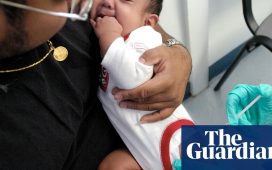Sepsis: Dr Chris reveals how to reduce risk of infection
Sepsis is a life-threatening condition that occurs when the body’s immune system overreacts to an infection and starts to attack tissues and organs.
If not dealt with quickly it can lead to sepsis shock causing your organs to fail.
It can happen to anyone, but a new study has found that some people are far more vulnerable to developing sepsis and more likely to die from the condition.
The analysis of NHS data shows that those with certain medical conditions and those living in more deprived areas are at greater risk of sepsis.
People with a “history of extensive antibiotic exposure” as well as people with learning disabilities, also have an increased risk, according to the research.

Severe breathlessness is one sign of sepsis (Image: Getty Images)
Co-author Professor Tjeerd van Staa, from the University of Manchester which led the study, said there was an “urgent need” to improve sepsis prevention in England.
As reported by The Sun, he said: “This study shows socioeconomic deprivation, comorbidity and learning disabilities are associated with an increased risk of developing non-Covid-19-related sepsis and 30-day mortality in England.
“This research underscores the urgent need for sepsis risk prediction models to account for chronic disease status, deprivation status, and learning disabilities, along with infection severity.
“There is an urgent need to improve the prevention of sepsis, including more precise targeting of antimicrobials to higher-risk patients.”
As part of the study, which has been published in the journal eClinicalMedicine, experts analysed data on 224,000 cases of sepsis from between January 2019 and June 2022 in England.
The team compared this information to data on more than 1.3 million people who did not have sepsis.

Slurred speech or confusion is another warning sign of sepsis (Image: Getty)
Information on income, employment, crime rate, living environment and education was utilised to measure socioeconomic deprivation.
It was ruled that people living in the most deprived communities were 80 percent more likely to develop sepsis compared to those from the least deprived.
People with a learning disability were at least three times more likely to be given a diagnosis of sepsis compared to people without.
Those with chronic liver disease also had a three-fold increased risk of developing sepsis, while people with chronic kidney disease had an increased risk of sepsis two to six times higher than the general population, depending on the stage of their disease.
Others found to be at greater risk for sepsis included people with:
- Cancer
- Neurological diseases
- Diabetes
- Immunosuppressive conditions.
Underweight or obese people, smokers and people of South Asian heritage were also at an increased risk for sepsis.

Smoking was one factor found to increase your risk of sepsis in the study (Image: Getty)
The study further found that deaths within 30 days of a sepsis diagnosis were highest among those aged in their 80s and people of white ethnicity.
However, people from deprived backgrounds, as well as with patients with chronic kidney disease and chronic liver disease also had an increased risk of dying within a month.
Study co-author Dr Colin Brown, lead for antimicrobial resistance and sepsis at the UK Health Security Agency, commented: “While severe infections and sepsis can impact anyone, our data is increasingly highlighting the complex interplay between socioeconomic status, underlying medical conditions and sepsis risk.
“Our research has found that some people were more likely to die from sepsis compared to others, including those in the lowest socioeconomic groups, and that those who need to take antibiotics more regularly are also at greater risk.
“Tackling inequalities is a core part of our public health approach and a deeper understanding of who serious bacterial infections affect will help us best target interventions to address them.”
Symptoms of sepsis
According to the NHS, the warning signs of sepsis can be “hard to spot”.
This is because the symptoms can be similar to the flu or other common conditions.
The UK Sepsis Trust uses the acronym SEPSIS for the key signs:
- Slurred speech or confusion
- Extreme shivering or muscle pain
- Passing no urine (in a day)
- Severe breathlessness
- It feels like you’re going to die
- Skin mottled or discoloured.
If you or another adult experiences these symptoms you should call 999.
In cases of septic shock a person might experience:
- Feeling dizzy or faint
- Confusion or disorientation
- Nausea and vomiting
- Diarrhoea
- Cold, clammy and pale or mottled skin.
Children can experience sepsis differently to adults.
The NHS urges people to call 999 or go to A&E if their child or baby:
- Has blue, grey, pale or blotchy skin, lips or tongue – on brown or black skin, this may be easier to see on the palms of the hands or soles of the feet
- Has a rash that does not fade when you roll a glass over it, the same as meningitis
- Has difficulty breathing (you may notice grunting noises or their stomach sucking under their ribcage), breathlessness or breathing very fast
- Has a weak, high-pitched cry that’s not like their normal cry
- Is not responding like they normally do, or not interested in feeding or normal activities
- Is being sleepier than normal or difficult to wake.











